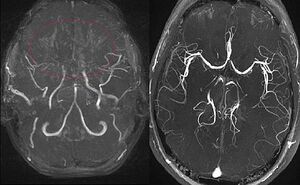Moyamoya Disease: Difference between revisions
Wendy Walker (talk | contribs) No edit summary |
Wendy Walker (talk | contribs) No edit summary |
||
| Line 16: | Line 16: | ||
== Clinical Presentation == | == Clinical Presentation == | ||
The patient often presents either in childhood, aged around 5 years | The patient often presents either: | ||
* in early childhood, aged around 5 years (two-thirds of patients) OR | |||
* in adults in their 30s or 40s (one-third of patients) | |||
In children, hemispheric ischaemic strokes are the most common presentation; in adults haemorrhage from the abnormal vessels is more common. | |||
Stroke or Transient Ischaemic Attack are the most common presentations, although some patients present with headaches or seizures. | |||
== Diagnostic Procedures == | == Diagnostic Procedures == | ||
Revision as of 18:38, 18 April 2024
Clinically Relevant Anatomy[edit | edit source]
Moyamoya Disease is a disorder of some of the blood vessels in the brain: the internal carotid arteries, and the arteries which branch from them. It is a rare cause of Stroke and TIAs.
It can also be referred to as Progressive Intracranial Occlusive Arteropathy, or Progressive Intracranial Arterial Occlusion.
Mechanism of Injury / Pathological Process
[edit | edit source]
The affected arteries become increasingly constricted with time, and a collateral circulation develops around the constricted arteries to compensate for the blockages. The condition is an idiopathic, non-inflammatory, non-atherosclerotic progressive vaso-occlusive disease involving the terminal supraclinoid internal carotid arteries and circle of Willis.
Clinical Presentation[edit | edit source]
The patient often presents either:
- in early childhood, aged around 5 years (two-thirds of patients) OR
- in adults in their 30s or 40s (one-third of patients)
In children, hemispheric ischaemic strokes are the most common presentation; in adults haemorrhage from the abnormal vessels is more common.
Stroke or Transient Ischaemic Attack are the most common presentations, although some patients present with headaches or seizures.
Diagnostic Procedures[edit | edit source]
Outcome Measures[edit | edit source]
add links to outcome measures here (see Outcome Measures Database)
Management / Interventions
[edit | edit source]
add text here relating to management approaches to the condition
Differential Diagnosis
[edit | edit source]
add text here relating to the differential diagnosis of this condition
Resources
[edit | edit source]
add appropriate resources here







